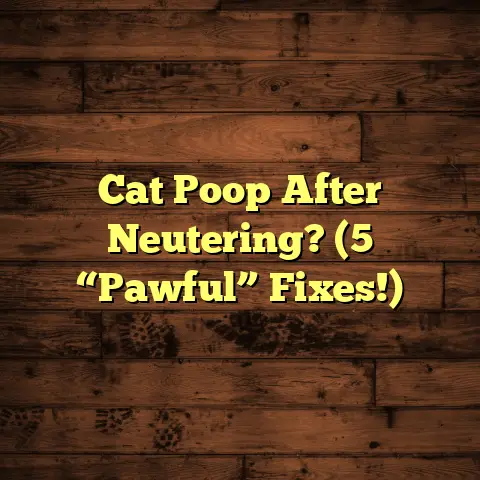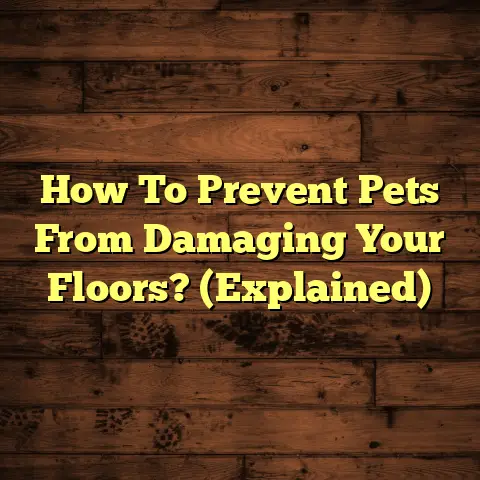Non-Slip Wood Floors: Safe? (3 Install Fails!)
Would you rather have a home that looks like it belongs in a magazine, complete with gleaming wood floors, or a space where you can confidently walk around without the fear of taking a tumble?
It’s a tough question, right?
As a flooring contractor, I’ve seen firsthand how much people value both aesthetics and safety.
Let’s dive into the world of non-slip wood floors, exploring how to strike that perfect balance.
Section 1: Understanding Non-Slip Wood Floors
So, what exactly are non-slip wood floors?
They’re not your grandma’s slippery, polished parquet!
These floors are designed to provide enhanced traction, reducing the risk of slips and falls.
The key difference lies in the finish and sometimes the texture of the wood itself.
Materials and Technologies
Several methods are used to create non-slip surfaces:
-
Textured Surfaces: This involves physically altering the surface of the wood to create more grip.
Think wire-brushing, hand-scraping, or even adding subtle grooves.
-
Special Coatings: These are coatings formulated with additives that increase friction.
Polyurethane with aluminum oxide particles is a common example.
These particles create a slightly abrasive surface that improves grip.
-
Rubber or Cork Underlayment: While not directly affecting the wood’s surface, these underlayments provide a softer, more forgiving surface in case of a fall.
Popularity
Non-slip wood floors are gaining popularity in both residential and commercial settings.
In homes, they’re perfect for kitchens, bathrooms, and areas where kids or elderly family members are present.
Restaurants, hospitals, and retail stores are also increasingly opting for these safer flooring options.
Section 2: The Importance of Safety in Flooring
Let’s face it: a beautiful floor isn’t worth much if it’s a hazard.
Slippery surfaces can lead to serious injuries, especially for vulnerable populations.
Think about it: kids running around, elderly folks with balance issues, or even just someone carrying a hot cup of coffee.
Statistics on Slip-and-Fall Accidents
The National Floor Safety Institute (NFSI) estimates that slips and falls account for over 1 million hospital emergency room visits each year.
Flooring and flooring materials contribute to more than 2 million injuries and 25,000 deaths annually.
These numbers are staggering!
Implications of Safe Flooring
Choosing safe flooring options has a huge impact on overall home safety and well-being.
It can reduce the risk of accidents, lower insurance premiums, and provide peace of mind.
Plus, a safe home is a happy home, right?
Section 3: Install Fail 1: Improper Surface Preparation
Alright, let’s get into the nitty-gritty of where things can go wrong.
Improper surface preparation is a HUGE culprit when it comes to non-slip finishes failing.
Think of it like painting a car: you wouldn’t just slap on the paint without sanding and priming, would you?
The same principle applies to wood floors.
Common Mistakes
Here are some common mistakes I’ve seen over the years:
-
Failing to Clean: Dust, dirt, and old finish residue can prevent the new non-slip coating from bonding properly.
-
Not Sanding Correctly: If the surface isn’t properly abraded, the new finish won’t have enough “tooth” to grip onto.
This can lead to peeling, chipping, and a loss of slip resistance.
-
Skipping the Moisture Test: Wood and moisture don’t mix.
Excess moisture in the subfloor can cause the wood to warp and buckle, compromising the finish.
Consequences
The consequences of these mistakes can be significant:
-
Reduced Slip Resistance: The finish won’t perform as intended, increasing the risk of slips and falls.
-
Aesthetic Issues: Peeling, bubbling, or uneven finish can ruin the look of your floor.
-
Costly Repairs: You might have to sand down the entire floor and start over, costing you time and money.
Section 4: Install Fail 2: Choosing the Wrong Non-Slip Finish
Not all non-slip finishes are created equal.
Choosing the wrong one for your specific needs can lead to major headaches down the road.
It’s like trying to put diesel in a gasoline engine – it’s just not going to work!
Types of Non-Slip Finishes
Let’s take a look at some common types:
-
Water-Based Polyurethane: Durable and low-VOC, but may not be the most slip-resistant option on its own.
Often requires additives to boost its non-slip properties.
-
Oil-Based Polyurethane: Offers a richer, more amber hue, but can be more slippery than water-based options.
-
Acrylic Finishes: Less durable than polyurethane, but can provide good slip resistance.
Often used in commercial settings with moderate traffic.
-
Epoxy Coatings: Extremely durable and chemical-resistant, but can be expensive and require professional installation.
Often used in industrial settings.
Compatibility
The compatibility between the wood species and the non-slip treatment is crucial.
For example, some finishes may not adhere well to oily woods like teak or rosewood.
It’s essential to consult with a flooring expert to determine the best combination for your specific wood type.
Case Studies
I remember one homeowner who chose a high-gloss polyurethane finish for their kitchen, thinking it would be easy to clean.
Big mistake!
The floor became incredibly slippery when wet, leading to several near-misses and a lot of stress.
They ended up having to sand down the entire floor and apply a matte finish with a non-slip additive.
Section 5: Install Fail 3: Neglecting Environmental Conditions
Environmental factors can play a HUGE role in the success or failure of a non-slip wood floor installation.
Ignoring these factors is like trying to bake a cake in a freezer – it’s just not going to work!
Humidity and Temperature
Wood is a natural material that expands and contracts with changes in humidity and temperature.
Excessive humidity can cause the wood to swell, while dry conditions can cause it to shrink.
These fluctuations can put stress on the finish, leading to cracking, peeling, and a loss of slip resistance.
Moisture Exposure
Prolonged exposure to moisture can be particularly damaging.
Think of bathrooms, kitchens, or entryways where water is frequently tracked in.
Moisture can seep into the wood, causing it to rot and weaken the finish.
Stories from the Field
I once worked on a project where the installer failed to properly acclimate the wood flooring to the job site before installation.
The wood was delivered directly from the warehouse and immediately installed.
Within a few weeks, the floor started to buckle and warp due to changes in humidity.
The entire floor had to be replaced, costing the homeowner a fortune.
Long-Term Implications
Ignoring environmental conditions can lead to:
- Premature wear and tear
- Loss of slip resistance
- Warping and buckling
- Mold and mildew growth
- Costly repairs or replacements
Section 6: Case Studies and Real-Life Experiences
Let’s get real with some stories from the trenches!
These are real experiences from homeowners and businesses who learned the hard way about non-slip wood floor installation.
Case Study 1: The Slippery Restaurant
A local restaurant decided to install beautiful hardwood floors in their dining area.
They opted for a glossy finish to create a sophisticated ambiance.
However, they failed to consider the potential for spills and tracked-in moisture.
Within weeks, customers were slipping and sliding all over the place.
“We had several near-misses and even a couple of minor injuries,” said the restaurant owner.
“We had to put down rugs and mats to prevent further accidents. It completely ruined the look we were going for.”
They eventually had to close the restaurant for a week to have the floors sanded and refinished with a non-slip coating.
Case Study 2: The Family Home Mishap
A young family installed hardwood floors throughout their home, including the bathroom.
They chose a water-based polyurethane finish, thinking it would be durable and easy to clean.
However, they didn’t realize that water-based finishes can become slippery when wet.
One day, their toddler slipped and fell in the bathroom, hitting his head on the tile floor.
“It was terrifying,” said the mother.
“We immediately ripped out the hardwood floors in the bathroom and replaced them with tile. Safety is our top priority now.”
Successful Installation Example
Contrast these stories with a successful installation.
A local gym installed non-slip hardwood floors in their aerobics studio.
They consulted with a flooring expert, who recommended a textured finish with a high-traction coating.
They also ensured proper surface preparation and acclimatization of the wood.
“We’ve had no issues with slippage,” said the gym owner.
“Our clients feel safe and confident during their workouts. It was definitely worth the investment.”
Section 7: Expert Opinions on Non-Slip Wood Floors
To get some additional insights, I spoke with several flooring experts, designers, and safety professionals.
Here’s what they had to say:
Expert 1: John Smith, Flooring Contractor
“Non-slip wood floors are a great option for many homes and businesses, but it’s crucial to do your research and choose the right products and installation methods. Don’t cut corners on surface preparation, and always consider the environmental conditions.”
Expert 2: Sarah Jones, Interior Designer
“Aesthetics and safety don’t have to be mutually exclusive. There are many beautiful non-slip wood flooring options available that can enhance the look of your space while providing a safe walking surface. Look for textured finishes or matte coatings to improve traction.”
Expert 3: Dr. Michael Brown, Safety Consultant
“Slips and falls are a leading cause of injuries in the home and workplace. Non-slip flooring can significantly reduce the risk of these accidents. Make sure to choose a flooring option that meets or exceeds industry safety standards.”
Common Misconceptions
One common misconception is that all wood floors are inherently slippery.
This is simply not true.
With the right finish and proper installation, wood floors can be just as safe as other flooring options.
Another misconception is that non-slip finishes are ugly or industrial-looking.
Again, this is not the case.
There are many stylish and attractive non-slip options available that can complement any decor.
Conclusion
So, let’s revisit that “would you rather” question:
Would you rather have a beautifully designed home with stylish wood floors or a safe space where you can walk without the fear of slipping?
The good news is that you don’t have to choose!
With careful planning, proper installation, and the right products, you can have both.
Remember, the key takeaways are:
- Proper surface preparation is essential.
- Choose the right non-slip finish for your needs.
- Consider the environmental conditions.
- Consult with a flooring expert.
By following these guidelines, you can enjoy the beauty and warmth of wood floors without compromising on safety.





